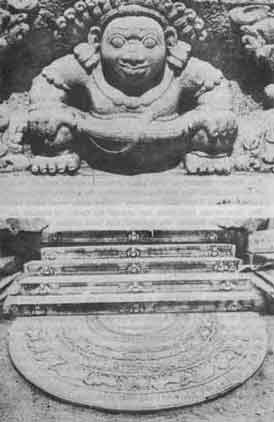
Continuing beyond the Rathna Prasada, there is an image house that contains one of the most perfectly executed sculptures in Sri Lankan art. The significance of ‘moonstones’ is debated, but they may well represent stages in the spiritual path. The meaning of the moonstone has been explained by Professor Paranavitana. The first ring on the outside of the stone depicts flames, which symbolize desire. Leaving behind desire and stepping into the next circle, there is a stately frieze of four animals; elephants, horses, lions and bulls pace around the ring. Passing beyond these fore sorrows, as the Buddha did, you reach a circle with a creeper and leaves. The twisting creeper symbolizes the life force, but when this craving is surpassed you reach the goose, which decides between good and bad. At this stage the goose again like the Buddha, leaves home and family behind, in search of truth. An exquisite scroll is the next ring, and the center is the lotus, symbolizing the region of purity and the approach to Nirvana.
Tragically the guard stones and makaras of this shrine are missing, but above the moonstone forcefully executed dwarfs hold up the steps. A base of an image shows where it stood. The buildings, which comprise the site, are of 8th or 9th century date, but they stand on an earlier site.

